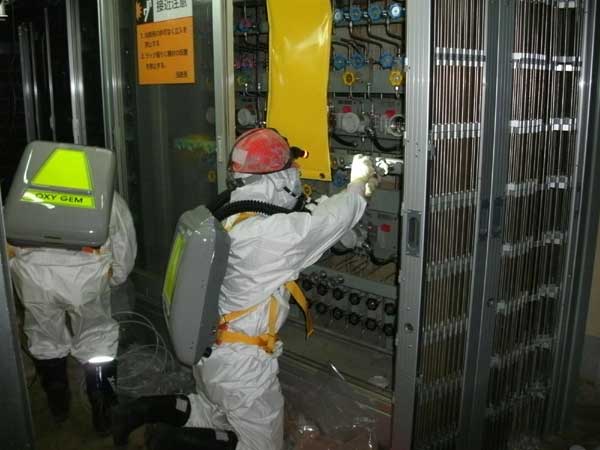Asia-Pacific
Nuclear fuel melted as rods fully exposed: TEPCO
(Xinhua)
Updated: 2011-05-12 17:30
 |
Large Medium Small |
|
Workers wearing protective suits check the status of the water level indicator at the fuel area inside Tokyo Electric Power (TEPCO) Co.'s crippled Fukushima Daiichi Nuclear Power Plant No.1 reactor in Fukushima Prefecture May 10, 2011 in this handout photo released by TEPCO on May 12, 2011.[Photo/Agencies] |
TOKYO - Tokyo Electric Power Co (TEPCO) said on Thursday that due to unexpectedly low levels of water, nuclear fuel rods are fully exposed in a reactor at the crippled No 1 Fukushima nuclear power plant.
According to the utility firm, the water level is 1-meter below the base of the nuclear fuel assembly meaning that a large amount of nuclear fuel is likely to have melted after being fully exposed.
"The water level is 1-meter below the base of the fuel assembly, " Junichi Matsumoto, a general manager at TEPCO, said at a news conference convened in Tokyo.
| ||||
Matsumoto explained that TEPCO, still struggling to contain the worst nuclear disaster since the 1986 Chernobyl catastrophe - following the March 11 megaquake and ensuing tsunami that struck northeastern Japan and crippled the Fukushima No 1 nuclear complex - was planning to flood the No 1 containment chamber, which surrounds the reactor vessel, to prevent the fuel from overheating. This process is known as water entombment.
But despite the plant operator insisting that water at the bottom of the reactor pressure vessel is keeping the melted nuclear fuel cool and that the surface temperature of the vessel was comparatively low at between 100 to 120 degrees Celsius, TEPCO 's water entombment plans will have to be changed.
"The plan needs to be revised," Matsumoto said. "We can't deny the possibility that a hole in the pressure vessel caused water to leak," Matsumoto said, adding that a further hydrogen explosion was, however, unlikely.
A TEPCO official surmised that the vast amounts of water injected into the reactor core in an emergency procedure to cool the fuel, had most likely leaked into the primary containment unit, suggesting that the utility firm's plans to flood the containment chamber to bring the ongoing nuclear crisis under control may have been flawed from the outset.
TEPCO has been trying to check the levels of water inside the No 1 reactor's pressure vessel and the outer primary container but have made slow progress due to dangerously high levels of radioactive materials.
But workers entered the No 1 reactor building for the first time last week since a blast destroyed its roof and following adjustments made on gauges that measure the water level at the reactor, found that the water level had dropped exposing as much as 1.5 to 1.7 meters of the nuclear fuel rods.
Hidehiko Nishiyama, a spokesman for Japan's Nuclear and Industrial Safety Agency, said that a system may need to be created whereby water already inside the vessel and primary containment unit is circulated around the reactor and used as an emergency coolant.
| 分享按钮 |




